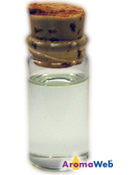Blue Cypress Essential Oil
Callitris intratropica

Description
The aroma of Australian Blue Cypress Essential Oil is woody yet sweet with a fruity/lemony quality. It is quite pleasant, and I can see its aroma being well suited for emotional as well spiritual applications. Although I would not exactly describe Blue Cypress Oil as being similar to Rosewood, Rosalina or Petitgrain, you are likely to enjoy the aroma Blue Cypress if you have a kinship to these other lighter, sweet wood oils.
I've read several references to Blue Cypress Oil being a grounding oil, and I can see it being useful for that purpose or for work with the root chakra especially where balance is needed. Within chakra work, Blue Cypress Oil may be helpful for use with the Root or Sacral chakras.
As its name indicates, Blue Cypress Essential Oil is typically pale blue in color. Salvatore Battaglia indicates that guaiazulene, a sesquiterpene, is responsible for the oil's beautiful blue hue and its anti-inflammatory properties. Guaiazulene is not present in the botanical material itself, but is formed during the distillation process. [Reference: Salvatore Battaglia, The Complete Guide to Aromatherapy Third Edition Volume 1 - Foundations & Materia Medica (Brisbane Australia: Black Pepper Creative, 2018), 263.]
This would be similar to the matricin present in German Chamomile converting to chamazulene during the distillation of German Chamomile Oil.
Blue Cypress is a conifer. For more information about conifer oils, read AromaWeb's Guide to Coniferous Essential Oils.
Blue Cypress Essential Oil Benefits and Uses
- Arthritis
- Asthma
- Fragrance Fixative
Source: Jeanne Rose, 375 Essential Oils and Hydrosols (Berkeley, CA: Frog, Ltd, 1999), 51.
Botanical Name
Plant Family
Common Method of Extraction
Steam Distilled
Plant Part Typically Used
Color
Pale Blue
Consistency
Thin
Perfumery Note
Top/Middle
Strength of Initial Aroma
Medium
Aromatic Description
Blue Cypress Essential Oil smells fresh and sweet and possesses notes that are reminiscent of lemon and cedar.
Major Constituents
- B-Eudesmol
- Dihydrocolumellarin
- Guaiol
- Gamma-Eudesmol
- a-Eudesmol
See Essential Oil Safety for a more complete list of typical constituents.
Source: L. Doimo, Azulenes, Costols and Gamma-Lactones from Cypress-pines (Callitris columellaris, C. glaucophylla and C. intratropica) Distilled Oils and Methanol Extracts. (Jounral of Essential Oil Research 13, 2001), 25-29. Source cited in Robert Tisserand and Rodney Young, Essential Oil Safety (Second Edition. United Kingdom: Churchill Livingstone Elsevier, 2014), 265-266.
Blue Cypress Essential Oil Safety Information
Avoid during pregnancy and lactation. It may interact with drugs and may be fetotoxic. Reading Tisserand and Young's full profile is recommended. [Robert Tisserand and Rodney Young, Essential Oil Safety (Second Edition. United Kingdom: Churchill Livingstone Elsevier, 2014), 266.]
General Safety Information
Do not take any oils internally and do not apply undiluted essential oils, absolutes, CO2s or other concentrated essences onto the skin without advanced essential oil knowledge or consultation from a qualified aromatherapy practitioner. For general dilution information, read AromaWeb's Guide to Diluting Essential Oils. If you are pregnant, epileptic, have liver damage, have cancer, or have any other medical problem, use oils only under the proper guidance of a qualified aromatherapy practitioner. Use extreme caution when using oils with children and be sure to first read the recommended dilution ratios for children. Consult a qualified aromatherapy practitioner before using oils with children, the elderly, if you have medical issues or are taking medications. Before using this or any essential oil, carefully read AromaWeb's Essential Oil Safety Information page. For in-depth information on oil safety issues, read Essential Oil Safety by Robert Tisserand and Rodney Young.
Shelf Life
Important Information About the Profiles
The essential oil information provided on AromaWeb is intended for basic educational purposes only. The references to safety information, test results, constituents and percentages is generalized information. Essential oils can vary greatly in composition. The data is not necessary complete and is not guaranteed to be accurate. The essential oil photos are intended to represent the typical and approximate color of each essential oil. However, essential oil composition and color can vary based on harvesting, distillation, age of the essential oil and other factors. Profiles for several CO2 Extracts and absolutes are included within the directory, and are denoted as such.